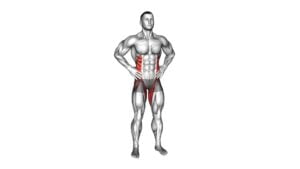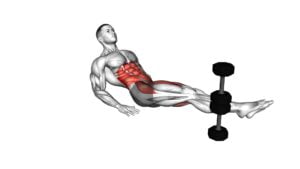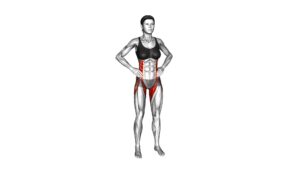Standing Side and Front Leg Raise – Video Exercise Guide & Tips

Are you looking to tone your leg muscles and improve your balance? Look no further than the standing side and front leg raises! In this article, we will guide you through the proper form and technique for these exercises, as well as provide tips for increasing intensity.
Watch This Exercise Video
By avoiding common mistakes, you'll be able to maximize the benefits of these leg raises. Get ready to feel the burn and achieve stronger legs with our video exercise guide and tips!
Key Takeaways
- Standing side and front leg raises improve balance and strengthen hip and thigh muscles.
- These exercises enhance overall lower body stability and challenge muscles in the legs and core.
- They target hip muscles to improve stability and prevent falls or injuries.
- Variations such as using ankle weights or performing on an unstable surface can increase the intensity and engage more muscles.
Benefits of Standing Side and Front Leg Raises
The benefits of performing standing side and front leg raises include improved balance, strengthened hip and thigh muscles, and enhanced overall lower body stability. When you incorporate these exercises into your fitness routine, you can effectively improve your balance by challenging the muscles in your legs and core.
Standing leg raises require you to engage your hip muscles to lift your leg to the side or front, helping to strengthen these muscles over time. By targeting the hip muscles, you can improve your stability and prevent falls or injuries. Additionally, these exercises also work the thigh muscles, such as the quadriceps and hamstrings, helping to tone and strengthen them.
This can contribute to better overall lower body stability and improve your ability to perform everyday activities with ease. So, if you want to improve your balance and strengthen your hip muscles, incorporating standing side and front leg raises into your workout routine is a great way to achieve these benefits.
Proper Form and Technique for Standing Side Leg Raises
To perform standing side leg raises with proper form and technique, lift your leg out to the side while engaging your hip muscles and maintaining a stable core. This exercise can be beneficial for increasing flexibility and strengthening the muscles of your hips and thighs.
Here are some tips to ensure you're performing standing side leg raises correctly:
- Stand tall with your feet hip-width apart and your hands on your hips.
- Keep your core engaged and maintain a neutral spine throughout the movement.
- Slowly lift one leg out to the side, keeping it straight and parallel to the ground.
- Avoid leaning or tilting your body to the side; instead, focus on using your hip muscles to lift the leg.
- Pause briefly at the top of the movement, then lower your leg back down in a controlled manner.
- Repeat the exercise for the desired number of repetitions, then switch to the other leg.
Variations of standing leg raises can add variety to your workout routine and target different muscle groups. Try performing the exercise with ankle weights or using a resistance band around your ankles to increase the intensity. Alternatively, you can perform standing leg raises on an unstable surface, such as a balance board or foam pad, to challenge your balance and engage more stabilizer muscles.
Remember to always listen to your body and modify the exercise as needed to avoid any discomfort or pain.
Proper Form and Technique for Standing Front Leg Raises
For proper form and technique in standing front leg raises, position yourself with your feet hip-width apart and your hands on your hips. This exercise targets your hip flexors, quads, and core muscles.
To begin, shift your weight onto one leg while keeping the other leg straight. Engage your core and maintain a neutral spine throughout the movement. Slowly lift your straight leg forward, ensuring that you maintain control and stability. Avoid swinging your leg or using momentum to lift it higher.
Pause at the top of the movement and then slowly lower your leg back to the starting position. Repeat for the desired number of repetitions and then switch legs.
To add variety to your workout routine, you can incorporate different variations of standing front leg raises. For example, you can perform the exercise while holding onto a stability ball or using ankle weights to increase the intensity. Additionally, you can also try performing the exercise on an unstable surface such as a balance board or a BOSU ball to challenge your stability and engage more muscles.
Remember to always start with proper form and gradually increase the difficulty as you become more comfortable and stronger. Incorporating leg raises into your workout routine can help improve your balance, strengthen your lower body muscles, and enhance your overall fitness level.
Tips for Increasing Intensity and Difficulty
If you want to increase the intensity and difficulty of your standing front leg raises, try incorporating these tips:
- Increase Resistance:
- Use ankle weights or resistance bands to add extra resistance to your leg raises. This will challenge your muscles and make the exercise more difficult.
- Gradually increase the weight or tension of the resistance as you become stronger and more comfortable with the exercise.
- Try Alternative Variations:
- Instead of raising your leg straight in front of you, try raising it at an angle to the side. This will target different muscles in your legs and hips, providing a new challenge.
- You can also try performing the leg raises on an unstable surface, such as a balance board or cushion. This will engage your core muscles and require more stability and control.
Incorporating these tips will help you take your standing front leg raises to the next level. By increasing the resistance and trying alternative variations, you can challenge your muscles in new ways and continue to progress in your fitness journey. Remember to listen to your body and start with a weight or variation that's appropriate for your current fitness level.
Common Mistakes to Avoid While Performing Standing Leg Raises
When performing standing leg raises, make sure to avoid common mistakes that can hinder your progress and potentially lead to injury.
One common error in standing leg raises is using momentum instead of controlled movements. Many people tend to swing their leg up using the momentum of their body, rather than engaging the targeted muscles. To avoid this mistake, focus on using your muscles to lift your leg, rather than relying on momentum.
Another mistake to avoid is lifting your leg too high. While it may seem like lifting your leg as high as possible will give you better results, it can actually put unnecessary strain on your lower back and hip joints. Instead, aim to lift your leg to a height where you can maintain proper form and control throughout the exercise.
Additionally, it's important to avoid leaning or tilting your upper body during standing leg raises. This can compromise your balance and put strain on your back. Keep your upper body upright and engage your core for stability.
Frequently Asked Questions
How Many Calories Can I Burn by Performing Standing Side and Front Leg Raises?
You can burn calories by performing standing side and front leg raises. To maximize calorie burn, focus on proper form and technique. Stand tall, engage your core, and lift your leg to the side or front while keeping it straight.
Incorporating standing leg raises into a full body workout routine can help target your lower body muscles and improve overall strength and stability.
Remember to start with a weight that challenges you but allows you to maintain proper form.
Can Standing Side and Front Leg Raises Help Improve Balance and Stability?
Standing side and front leg raises are exercises that can improve your balance and stability. By performing these movements, you challenge your body to maintain control and coordination. This helps to strengthen your leg muscles, which are essential for stability.
Additionally, the side and front leg raises engage your core muscles, further enhancing your balance. Incorporating these exercises into your routine can be a beneficial way to work on improving your balance and stability.
Are There Any Modifications or Variations of Standing Side and Front Leg Raises for Beginners?
When starting out with standing side and front leg raises, it's important to keep in mind that there are modifications and variations available for beginners. These modifications can help make the exercise more accessible and beginner-friendly. By making small adjustments, such as reducing the range of motion or using a support, you can gradually build strength and stability.
It's always a good idea to consult with a fitness professional to ensure proper form and technique.
How Many Sets and Repetitions Should I Do for Standing Side and Front Leg Raises to See Results?
To see results in standing side and front leg raises, it's important to find the optimal frequency and duration that works for you.
Start with two sets of 10-12 repetitions each, and gradually increase as you get stronger.
Aim to do this exercise 2-3 times a week for best results.
To maximize your progress, try incorporating progression techniques like adding ankle weights or using a resistance band.
Consistency and gradual progression will help you achieve your desired results.
Can Standing Side and Front Leg Raises Help With Reducing Hip and Lower Back Pain?
Standing side and front leg raises can definitely help with reducing hip and lower back pain. By incorporating these exercises into your routine, you can improve flexibility and mobility in those areas, which can alleviate discomfort.
However, it's crucial to ensure that you're performing the exercises with proper form and technique to maximize their benefits and prevent any potential injuries.
Don't forget to engage your core and focus on controlled movements throughout the exercises.
Conclusion
In conclusion, standing side and front leg raises are effective exercises for targeting and strengthening the muscles in your legs. By performing these exercises with proper form and technique, you can maximize their benefits and avoid common mistakes.
Additionally, by following the tips provided and gradually increasing intensity, you can make these exercises more challenging and continue to progress in your fitness journey.
So, incorporate standing side and front leg raises into your workout routine for stronger and more toned legs.

Author
Years ago, the spark of my life’s passion ignited in my mind the moment I stepped into the local gym for the first time. The inaugural bead of perspiration, the initial endeavor, the very first surge of endorphins, and a sense of pride that washed over me post-workout marked the beginning of my deep-seated interest in strength sports, fitness, and sports nutrition. This very curiosity blossomed rapidly into a profound fascination, propelling me to earn a Master’s degree in Physical Education from the Academy of Physical Education in Krakow, followed by a Sports Manager diploma from the Jagiellonian University. My journey of growth led me to gain more specialized qualifications, such as being a certified personal trainer with a focus on sports dietetics, a lifeguard, and an instructor for wellness and corrective gymnastics. Theoretical knowledge paired seamlessly with practical experience, reinforcing my belief that the transformation of individuals under my guidance was also a reflection of my personal growth. This belief holds true even today. Each day, I strive to push the boundaries and explore new realms. These realms gently elevate me to greater heights. The unique combination of passion for my field and the continuous quest for growth fuels my drive to break new ground.



